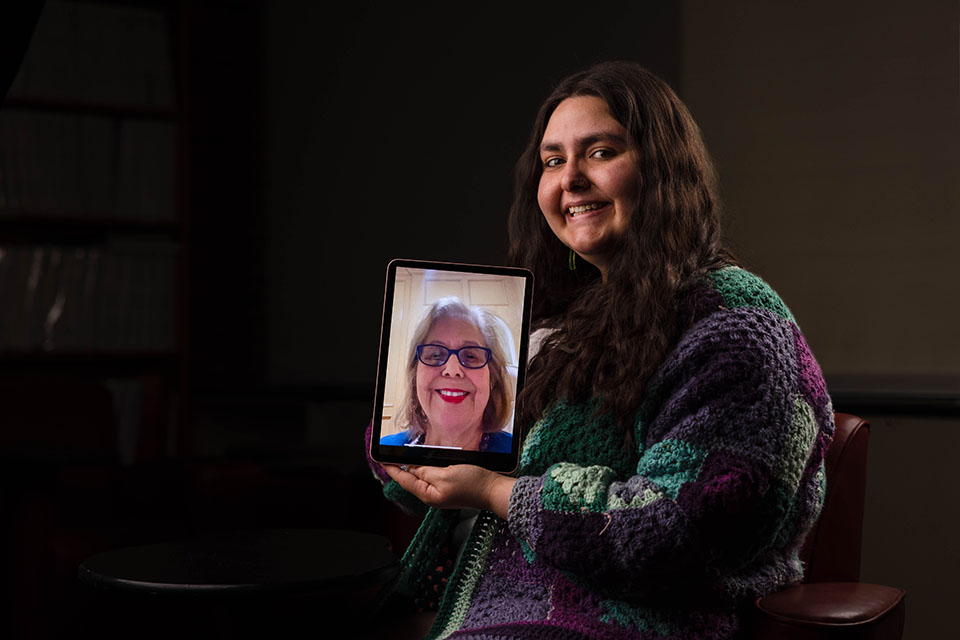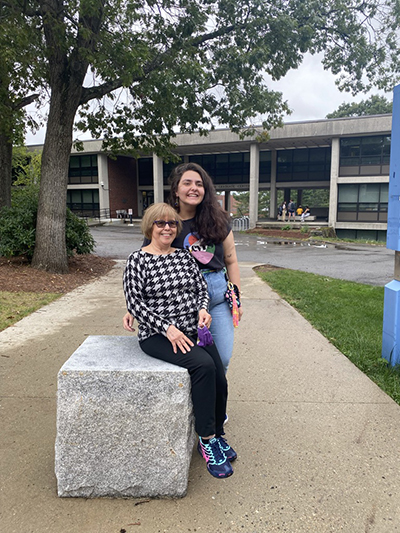Exploring CHamoru traditions: An intergenerational story
jessie neal, GSAS MA '23, has spent their graduate program dedicated to exploring CHamoru culture. Their greatest resource? Their grandmother.
 Photo/Gaelen Morse
Photo/Gaelen Morseneal decided that accurately highlighting the history and life of CHamoru people required the perspective of someone very special: neal's grandmother, Teresita Ignacio Santos Currie.
On the first day of the Women’s, Gender, and Sexuality Studies program seminar, professor V Varun Chaudhry challenged students to pick a list of potential thesis topics.
When jessie neal (they/she), GSAS MA’23, proposed researching the CHamoru people, their family’s cultural heritage, the class looked puzzled.
CHamoru peoples are the Indigenous people from Guåhan (the CHamoru word for Guam) in the Mariana Islands. While some Pacific Islander cultures, like those in Hawai’i, are well-known because of their prominent tourism, many people aren’t familiar with CHamoru culture.
“Everyone seemed curious and genuinely interested in learning more. That was the moment I knew I needed to share this story,” neal said, explaining that they decline to capitalize their own name in a symbolic gesture to focus on their research subjects, not themself.
With the support of their mentors, professor ChaeRanFreeze and professor V Varun Chaudhry, neal focused their thesis on an exploration of CHamoru culture through research and first-hand knowledge.
“It’s been awesome being around people who are willing to learn about different cultures,” said neal. “As my advisers, they really came along with me for this experience. It’s been great seeing them get really into Pacific Islander literature.”
A CHamoru perspective
As neal started their research, they discovered most resources on the CHamoru were written by people outside of the culture.
neal decided that accurately highlighting the history and life of CHamoru people required the perspective of someone very special: neal's grandmother, Teresita Ignacio Santos Currie.
In CHamoru culture, a woman leads the matriarchal family unit. Respect and values are centered upon family, community, and most importantly, the elders.
Currie naturally assumes the leadership role in her family unit, despite the traumatic experiences she left behind in Guåhan, including the Japanese occupation of Guam during World War II. She immigrated to the United States in 1955.
Many of her family members were sent to labor camps, became prisoners of war, and experienced war crimes. To protect her children from these experiences, her great grandmother sent Currie to hide in the jungle during the Japanese head counts.
“My nana is 85 years old, and even now, more than 50 years later, discussing her experiences in Guåhan is a raw, emotional topic for her,” said neal in their thesis. “Both because of how long she has been separated from the island, and the trauma that has been interwoven within these memories.”

Neal's grandmother, Teresita Ignacio Santos Currie visiting the Brandeis campus.
Nana uncovers her childhood
After slowly helping their grandmother get comfortable sharing more details, neal conducted a series of interviews.
As the conversations unfolded, they learned more about their grandmother’s childhood memories, family structures, trauma, and insight into the United State’s attempted erasure of the CHamoru culture. Their grandmother shared stories of her family structure in Guam and CHamoru traditions.
When the U.S. occupied Guam in 1944, some CHamoru people felt a sense of patriotism and gratitude for their new sense of safety. However, the U.S Navy banned the CHamoru language, and CHamoru children who spoke the Fino’CHamoru language in school were punished.
Neal’s grandmother stopped using the language in her childhood and, as a result, hasn’t passed it on to her children or grandchildren. Instead, neal's grandmother considers herself primarily a U. States citizen.
While neal’s grandmother may feel distant from her heritage, her everyday interactions and family leadership connect her to CHamoru cultural traditions. Currie enjoys attending church, playing card games, and being an active part in her children and grandchildren’s lives.
“She’s very stubborn, but that’s also how CHamoru elders are,” said neal. “I can’t ask her to overcome countless years of people telling her that her culture didn’t exist.”
Continuing a legacy
Seeking to reconnect to their family’s cultural roots, neal chose to enroll in an online CHamoru language course taught by the University of Guam. She see this as an opportunity to make sure the language isn’t forgotten.
“As the only person in my family who knows some of the language, I feel responsible for using CHamoru words whenever possible,” said neal.
While this research started primarily as a thesis focus, it has become neal’s passion and inspiration towards their next step: finding a PhD program that supports their dream of writing a book about the CHamoru people from their own perspective. With the continued help of their program mentors, neal has found a university that will embrace their next endeavor. They will be attending the University of Michigan’s American Culture PhD program in the Fall.
“Having someone in academia advise me on which universities would be interested in letting me pursue this project in the way I choose has been awesome,” said neal. “My program mentors in Women’s, Gender and Sexuality Studies saw the work I did, believed in me, and funded me. I don’t feel like that would’ve been possible at other institutions.”
Neal hopes their book will explore the culture, traditions, and everyday life within a CHamoru family, sharing accounts from their cousins, aunts, uncles, and most importantly, their Nana.
“I don’t want this to be an academic textbook that gets lost in the library,” she said. “I want CHamoru people to see themselves represented in the text.”Categories: General, Humanities and Social Sciences, International Affairs, Research, Student Life





